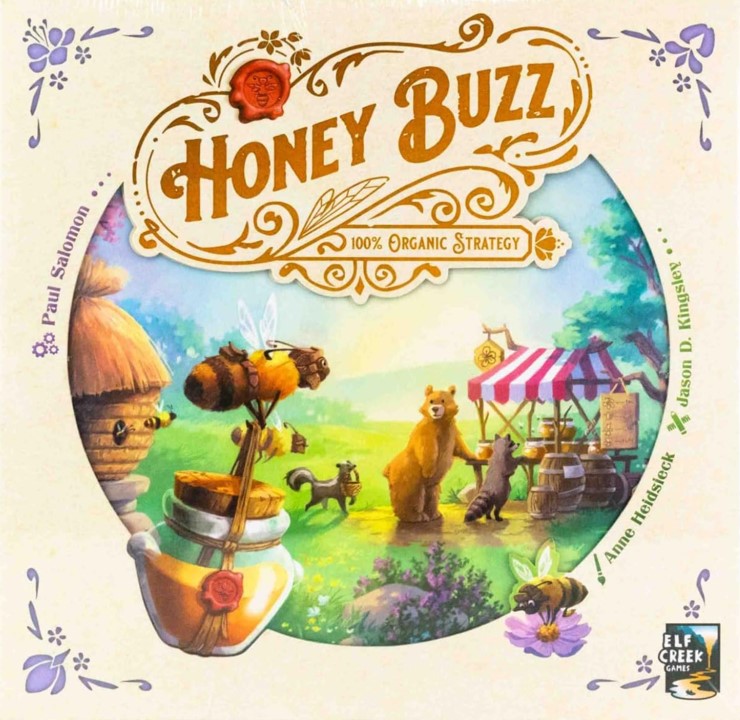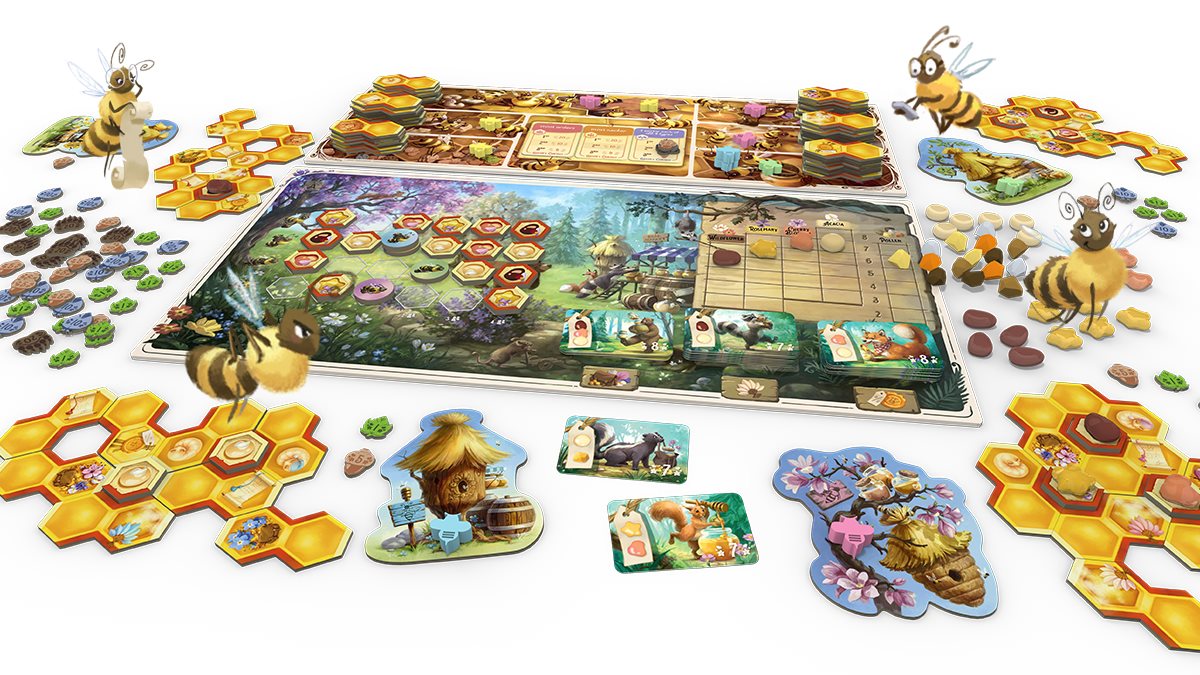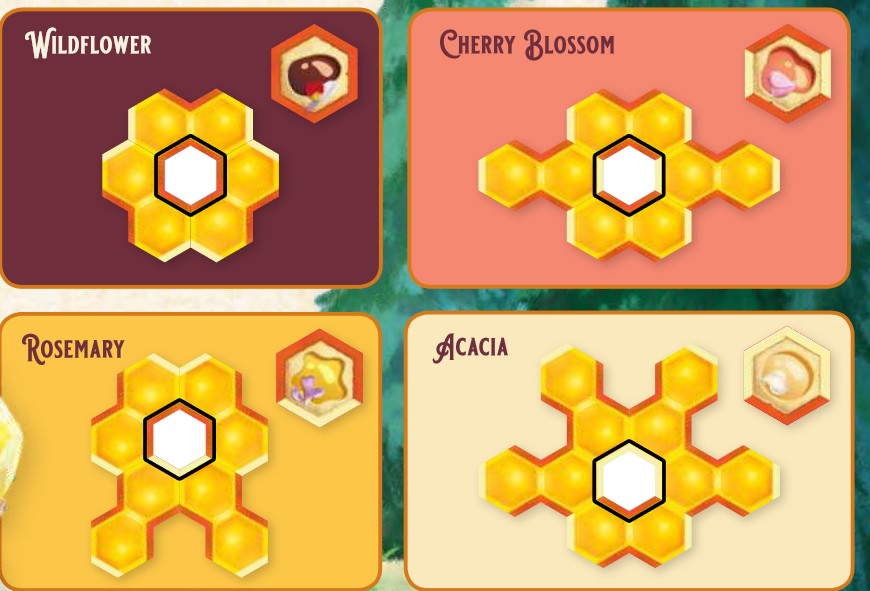“The bees have discovered economics!” is probably my favorite line from any rulebook I’ve seen as of late, although I love the term “beeples”. While the tabletop game “Apiary” features space bees, “Honey Buzz” has bees of the more regular sort and tasks players with competing for the Queen’s favor by earning the most victory points…as Earth bees tend to do. Special thanks to Elf Creek Games & their PR company for sending a copy.
1-4 Players, Ages 10+, Average Playtime = 45-90 Minutes
—
Components & Setup
There are three pages in the rulebook dedicated to components and setup, so I’ll opt to give you the highlights.
The general game boards will be supplied with standard hive tiles of six types, with each type / stack going into their own assigned spaces. Three queen’s contest cards are at chosen at random, one from each of the three different decks. Small Order and Large Order cards are specially seeded into three stacks. Resource tokens are added to the market (1 per column) and players choose a first player. Players get a set of player pieces in their color along with starting hive tiles, worker “beeples”, a forage token, and a fan token. A configuration card will determine how players’ hives will look for setup. Nectar tiles are seeded into the field based on player count and players’ forage tokens are added to their starting spaces.
There’s a lot more so check out the rulebook.
—
Gameplay Overview
The game is played over a series of player turns until one of two victory conditions is met. A player, on their turn, will either assign a worker & take a tile OR recall all their workers. If a player wants to assign a worker & take a tile they’ll have to assign one more beeple than the number the last player assigned to that space. Players usually only start with one active beeple but may start with two depending on player count and position.
There are six different worker spaces and they all do different things. Forage lets you move your forage token around the field to collect nectar or pollen, Produce lets you produce honey, Decree lets you take any action at the cost of 5 coins, Accounting gives you five coins from the bank, Market lets you sell to the market or complete orders, and New Bee adds a new worker to your workforce. Doing any of these requires the player to take the related tile and add it to their personal honeycomb.
Making a donut-hole / empty cell with your honeycomb configurations allows the player to perform all actions lists on adjacent tiles for free (without taking more tiles). During the Forage action, players can fill empty cells by collecting one of four types of nectar tiles. However, each type has a required border configuration that must be satisfied. The Produce action then produces the matching honey type on that nectar tile.
Players earn points by earning coins, honey, and pollen (1:1) as well as completing contests and orders. The game ends when all but one of the market resources have dropped to its lowest space OR when orders in two of the three stacks have been depleted.
There’s more but I’ll defer you to the rulebook (link above) for specifics.
—
The Review
The theme. The components. *Chef’s Kiss* Everything is oh, so sweet. Even the honey tokens looked edible (protip: they’re not). Like “Apiary”, “Wingspan”, and other high-quality games out there, “Honey Buzz” doesn’t disappoint. I also love it when rule-books are made of that leathery material…whatever its called. Dammit Jim, I’m a review critic, not a tanner.
Solo players will be pleased to know that there is a solitaire variant that tasks you with getting a high score while dealing with layabout drones. There are adjustable difficulty levels as well. There’s also an advanced variant that changes the way the field of nectar tiles behave. By default nectar tiles are setup face-up, but the advanced variant has them kept face-down for scouting and discovery. It adds a memory element to the game that I personally don’t care for, so I stuck with the regular rule set.
As a person with an accounting background I was hoping there would be more to the market. Here, the resources start at the top / max value and only drops during the game as players sell that resource type. That said, the game is complicated enough for my tastes so I was somewhat fine with the simplicity of the market.
Simplicity…despite all the things you can do in “Honey Buzz”, I feel like there’s nothing I haven’t already seen before. You’re assigning workers while puzzling your honeycomb and managing resources. I got some “Stone Age” vibes in various ways, though I’m sorry to say that “Apiary” is still the better game. I shouldn’t have to add, “in my opinion” to that sentence, but will remind folks of it anyway. I’d be remiss if I didn’t point out that at this time, Apiary is harder to find and $70+. Honey Buzz is more accessible at the $25-$30 price point.
I like “Honey Buzz” and it has excellent table presence, but the gameplay didn’t WOW me in any particular way. It’s a good game, don’t get me wrong. I’d still recommend it for mid-casual gamer families wanting a bit more from your average casual game.
—
Score: 7/10 (Good)




